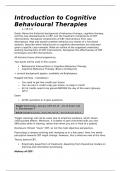Class notes
College aantekeningen Introduction to cognitive behavioural therapies (PSB3E-KP07)
- Course
- Institution
This is a summary of all courses in the course: Introduction to cognitive behavioural therapies (PSB3E-KP07). Personally, these notes were enough for me to successfully complete this course. Hope I can help someone else and more!
[Show more]



